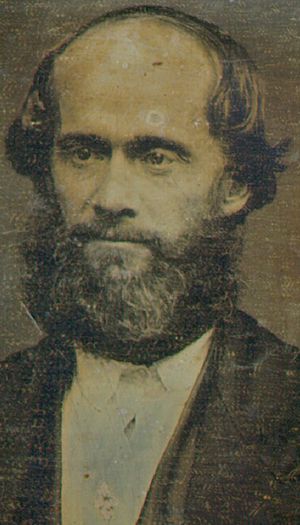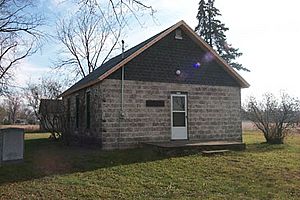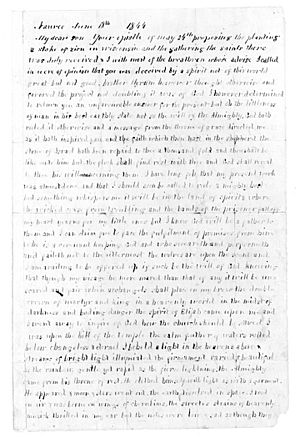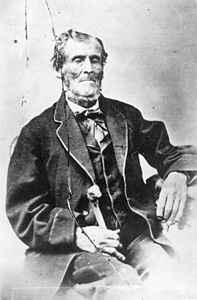Church of Jesus Christ of Latter Day Saints (Strangite) facts for kids
Quick facts for kids Church of Jesus Christ of Latter Day Saints (Strangite) |
|
|---|---|

1856 daguerreotype of James Strang, taken on Beaver Island, Lake Michigan
|
|
| Classification | Latter Day Saint movement |
| Orientation | Latter Day Saints |
| Theology | Mormonism; Psilanthropist; Unitarian |
| Polity | Church conference |
| Moderator | None, after Strang's death |
| Region | Worldwide |
| Founder | Joseph Smith Jr, 1830; James J. Strang, 1844 |
| Origin | April 6, 1830 (officially given); June 27, 1844 (claimed angelic ordination of Strang) Voree, Wisconsin |
| Separated from | Church of Jesus Christ of Latter Day Saints |
| Separations | Church of Jesus Christ (Drewite), Church of the Messiah, Holy Church of Jesus Christ, others |
| Congregations | 6 |
| Members | 130 |
The Church of Jesus Christ of Latter Day Saints (Strangite) is a religious group that believes it is the true continuation of the church started by Joseph Smith in 1830. It is different from the much larger church based in Utah, The Church of Jesus Christ of Latter-day Saints. Both groups believe they are the original church Joseph Smith founded.
The Strangite church is based in Voree, Wisconsin. Its members follow the teachings of James Strang, who they believe was Joseph Smith's chosen successor. In 1998, the church had about 300 members. Today, its official website reports around 130 active members across the United States.
After Joseph Smith was killed in 1844, there was no clear leader for his church. Many people claimed they should be the next leader. James Strang was one of these claimants. He competed with other important church members like Brigham Young and Sidney Rigdon.
At its largest, the Strangite Church had about 12,000 members. This made them a notable rival to Brigham Young's group. James Strang was killed in 1856. After his death, most of his followers joined Joseph Smith III's church, which is now called the Community of Christ.
Contents
History of the Strangite Church
Before James Strang's Leadership
The Strangite Church shares its early history with other Latter Day Saint groups. This shared history goes up to the time Joseph Smith was killed in 1844. After Smith's death, a crisis happened over who would lead the church next. Several early leaders claimed they should be the new prophet. These included Sidney Rigdon, Brigham Young, and James Strang.
Sidney Rigdon believed he should lead because he was a senior member of Smith's top leadership group. When the main church in Nauvoo, Illinois, did not accept him, Rigdon and his followers moved to Pittsburgh, Pennsylvania. His group eventually faded away.
Brigham Young first argued that Smith could not have an immediate replacement. Instead, he said that the Quorum of the Twelve Apostles, which he led, should guide the church. Young and his followers traveled west to the Salt Lake Valley in what is now Utah. They continued to use the name Church of Jesus Christ of Latter Day Saints.
James Strang's Claims to Leadership
James Strang was a newer member of the church when Joseph Smith died. Yet, he became a strong challenger to Young and Rigdon. Strang was an elder in the church. He was tasked with setting up a safe place in Wisconsin. This was in case Mormons had to leave their main city of Nauvoo.
Strang had a document called the "letter of appointment." He said Joseph Smith wrote it before he died. Some people questioned if Smith's handwriting matched the letter. Also, the letter's words were unclear. Some believed it only made Strang a leader in Wisconsin. But Strang and his followers thought it meant he was Smith's successor. Strang also claimed that angels visited him when Smith died. He said they ordained him as the new prophet. He was the only witness to this event.

Many Latter Day Saints liked Strang's idea of new messages from God through a living prophet. People were sad after Smith's death. Strang promised that there was still a prophet who talked with God and angels. Strang's claim was also supported by his discovery of the Voree plates. He said these plates contained the words of an ancient Native American leader. These plates were found on the Hill of Promise in Voree, where a temple would later be built. This event reminded people of Joseph Smith finding and translating the golden plates for the Book of Mormon. This may have led some to follow Strang over other leaders.
Early Successes and Challenges
Many important Latter Day Saints believed Strang's "letter of appointment." They accepted him as the second prophet of Mormonism, at least for a while. These included Joseph Smith's only living brother, William Smith. Also, Martin Harris, who helped publish the Book of Mormon, joined Strang. Other leaders and even Joseph Smith's mother, Lucy Mack Smith, followed Strang.
However, most of these early followers left the Strangite church by 1850. Many left because Strang changed his mind about a practice of having more than one spouse. At first, Strang was strongly against this practice. But in 1849, he changed his mind and became a strong supporter. Many of his early followers had joined him because he was against this practice, unlike Brigham Young. So, Strang's decision caused him and his church to lose many members.
Strang found his strongest support among smaller groups of Mormons scattered around. He often visited these groups. His followers may have reached 12,000 people. Strang's church also sent missionaries to England. This was a main place where Mormons found new members. Martin Harris led this mission. However, he was not a good speaker, and the English missions mostly sided with Brigham Young's church.
Building a Community on Beaver Island
It was expensive to buy land in the Voree area. This made it hard for Latter Day Saints to gather there. So, Strang moved his church's main center to Beaver Island in Lake Michigan. His followers built a town there called St. James. In 1850, Strang openly set up a church kingdom with himself as the spiritual "king" of his church. The date of his crowning, July 8, is still one of the two most important days in the Strangite church calendar. The other is April 6, the day Joseph Smith's church was founded.
Strang never claimed to be king of Beaver Island itself. He said he was king over his church. He saw his church as the true "Kingdom of God" that the scriptures talked about. The rules for this kingdom were in the Book of the Law of the Lord. Strang said he translated this book from ancient plates. This book was first published in 1851. A much larger version came out in 1856, just after Strang was killed. Strangites still respect this book today. It is a very important part of their scriptures.
The Strangite printing press on Beaver Island also printed a newspaper called the Northern Islander. This was the first real newspaper in northern Michigan. St. James became a busy port for ships on the Great Lakes. The Strangites started to compete with older trading ports like Mackinac Island. Disagreements grew between the Mormons on Beaver Island and their non-Mormon neighbors. These often led to fighting. Both sides accused each other of bad behavior. Also, some of Strang's own followers became unhappy with what they saw as his strict rule.
On June 20, 1856, two unhappy Strangite members shot Strang in the back. He died three weeks later. Strang had not named a successor. He said the next Strangite prophet had to be chosen by angels, just like he and Smith were. So, Strang's church was left without a leader and was vulnerable. The day before he died, people from Mackinac Island and other Lake Michigan communities came to Beaver Island. The Strangites were forced onto ships and removed from the island. Most were left on docks in Chicago and Green Bay, with nothing.
After James Strang's Death

Strang's death and the loss of Beaver Island were huge disasters for his church. Many Strangites felt lost and without spiritual guidance. Most of them eventually joined the "New Organization" of Latter Day Saints. This group had chosen not to follow Brigham Young. They later accepted the leadership of Joseph Smith III, Joseph Smith's oldest son. This "New Organization" became the Reorganized Church of Jesus Christ of Latter Day Saints. It is now the second-largest group in the Latter Day Saint movement.
However, a few Strangite congregations remained loyal to their prophet's memory. Wingfield W. Watson, a high priest who knew Strang, kept the Strangite church alive into the 1900s. Today, Strang's followers are divided into two main groups. One group is led by a Presiding High Priest. This leader does not claim to have the same authority as Smith or Strang. The other group believes the first group made mistakes by changing its organization. This second group claims it is the only true remaining part of Strang's church.
The first group does not focus on missionary work anymore. They believe that after three prophets were killed (Joseph Smith, Hyrum Smith, and Strang), God stopped sending new messages to people in the West. Because of this, this group remains small. Membership numbers vary, but are usually between 50 and 300 people.
Sacred Texts
Strangites believe the Bible is the word of God if it is translated correctly. They also believe the Book of Mormon is the word of God. This is similar to most other Latter Day Saint groups. They also consider earlier versions of the Doctrine and Covenants to be scripture.
Strangites believe Joseph Smith's special translation of the Bible was inspired. However, they do not think modern versions of this text are accurate. So, they carefully use an early publication of his corrections. Strangites do not have an official view on the Book of Abraham.
Strang's Book of the Law of the Lord is accepted as scripture in its expanded 1856 form. They believe it is the same "Book of the Law of the Lord" mentioned in the Bible. Strang claimed he translated it from ancient plates.
The Strangites also consider several prophecies, visions, and translations by Strang to be scripture. These are found in the Revelations of James J. Strang. This text includes his claimed "letter of appointment" from Smith and his translation of the Voree plates.
Beliefs and Practices
Church Leadership
One unique difference for Strangites is how they organize their priesthood. Strang's Book of the Law describes special levels within the Melchizedek and Aaronic priesthoods.
In the Melchizedek priesthood, Strang named two main "orders": Apostles and Priests.
- The Prophet/President of the Strangite church is called a "King."
- The President's counselors are called "Viceroys."
- Strang's Twelve Apostles are called "Princes."
- A group of "Evangelists" was also planned. These would be Apostles to a single group of people, unlike the Twelve who went to all nations. This is a unique church office.
Priests are divided into High Priests and Elders.
- High Priests include "inferior Kings, Patriarchs, or heads of tribes." They are called "Sons of God." The king chooses counselors and judges from this group.
- The office of Elder includes both Seventies and Elders, as in Smith's church.
In the Aaronic priesthood, Strang named three "orders": Priests, Teachers, and Deacons.
- Priests are divided into Sacrificators and Singers. Women can be Singers.
- Teachers are divided into five levels. This office is also open to women. Teachers teach both religious and everyday subjects. They are meant to work in schools.
- Deacons are divided into Marshals, Stewards, and Ministers. They serve as "Stewards and keepers of the King's prisons."
Today, there are no Apostles in the Strangite church. This is because Apostles must be appointed by a Strangite prophet. And the prophet himself must be appointed by God through angels. The "incorporated" group of Strangites has high priests. But the "non-incorporated" group does not. Both groups have Elders and Aaronic Priesthood offices.
The Ten Commandments
Another unique part of Strangite belief is their version of the Ten Commandments. The Strangite Decalogue is different from other versions. It includes the commandment: "Thou shalt love thy neighbor as thyself."
This teaching is found in the Bible in other places. Strang believed his fourth commandment was lost from other versions of the Ten Commandments long ago. All other Latter Day Saint groups reject Strang's version of the Decalogue.
Women in Leadership
As mentioned, the Strangite church allows women to hold two priesthood offices: Priest and Teacher. Women can be "Singers" in the Priest office. They can also hold all five levels in the Teacher office. Strang began ordaining women to these roles as early as 1851. He also allowed them to speak in his School of the Prophets by 1856. Another church, the Community of Christ, started ordaining women in 1984. Most other Latter Day Saint churches do not ordain women.
Animal Sacrifice
Animal sacrifice was started in the Strangite church under Strang's leadership. It was mainly part of their celebration rituals. While Strang's Book of the Law of the Lord talks about sacrifices for sins, Strang focused on them as part of religious festivals. This was especially true for the celebration of his own crowning as king on July 8, 1850. The head of each household was to offer "a heifer, or a lamb, or a dove."
Strangite Priests were allowed to kill sacrifices. However, female Priests were not allowed to do this. Offerings of "firstfruits" were also required from all Strangite farm harvests.
Strangites no longer practice animal sacrifices today. However, they still believe that the practice is correct.
God and Jesus Christ
Strangites do not believe in the traditional Christian idea of the virgin birth of Jesus Christ. They also reject the Mormon idea of many gods. They believe there is only one eternal God, the Father. They believe that becoming a god is not possible. They teach that God has always been God, and He is one Person.
Strangites believe Jesus Christ was the natural son of Mary and Joseph. They believe he was chosen before all time to be the Savior. But he had to be born as an ordinary human to truly fulfill his role. Strang claimed that Jesus was "adopted" as God's son at birth. This was fully shown during the transfiguration. After living a perfect life, Jesus was able to offer a sacrifice for people's sins. This happened before his resurrection and ascension.
Free Will
Strang wrote a lot about the nature of sin and evil. He believed that God could give humans everything except experience. So, for humans to have true "free will," they must have the chance to make mistakes and learn from them. The main goal for each person, according to Strangites, is to willingly become like God in every way. They should choose good over evil, not because of fear or reward, but because goodness is beautiful and pure.
Sabbath Day
Strangites observe the seventh-day Sabbath, which is Saturday. This is commanded in the Book of the Law, instead of Sunday.
Baptism for the Deceased
Strangites believe in baptism for the dead. They practiced it a little in Voree and on Beaver Island. However, Strang required a special message from God to perform a baptism for someone who was not a close relative. This message could come through dreams or angelic visits. While still believed in, baptisms for the dead are not done in the Strangite church today. This is because they do not have a temple or a prophet to lead them.
Eternal Marriage
Eternal marriage is taught in the Strangite church. But unlike in the LDS Church, it does not have to be done in a temple. Strangite Priests, Elders, High Priests, or Apostles can perform this ceremony. Eternal marriages are still performed among Strangites today.
Caring for Resources
Strangites are required to care for forests and other resources. In Strang's Beaver Island community, and other places where Strangites lived, groups of trees were to be kept on every farm, village, and town. Farms and cities without trees had to plant them. They also had to create parks for people to rest and play. Even though Strang's kingdom is gone, his followers still try to practice basic conservation.
Plural Marriage
The practice of having more than one spouse is allowed, but not strictly commanded, in the Book of the Law. The text says: "Thou shalt not take unto thee a multitude of wives disproportioned to thy inheritance, and thy substance: nor shalt thou take wives to vex those thou hast; neither shalt thou put away one to take another." Any wife already married had the right to share her opinion, and even object, but not to stop the marriage.
Strang defended this practice by saying it helped women. He claimed it gave them more freedom. It allowed them to choose the best possible partner, even if that person was already married. This way, a woman could marry someone she felt was most compatible, who could be a good parent to her children, and who could give her the best life, no matter how many other spouses he had.
The practice of having more than one spouse has never been officially forbidden in the Strangite church. Only twenty-two men practiced it, and most took only one additional spouse. Strang himself took four additional spouses, the most of anyone in his church.
This practice was apparently done by a few Strangites until about 1880. However, with government bans on the practice, and a religious rule to obey "the law of the land," it has been stopped in the modern Strangite organization. But the belief that it is correct is still required.
Strangites reject a specific section (Section 132) of the LDS Church's Doctrine and Covenants. They believe it was a fake document from 1852 and was never approved by Joseph Smith.
Temples
Strang began building a temple in Voree. But he could not finish it because his followers were poor and did not cooperate enough. Strangites believe that only a prophet of God can receive a message to direct the building of a Temple. Since there is no current prophet of the church, there are no plans to build a Temple now.
African Americans
Strangites welcomed African Americans into their church. Some other groups (like the LDS Church, until 1978) did not allow them to hold priesthood offices or have certain church benefits. Strang ordained at least two African Americans to the eldership during his lifetime.
See also
 In Spanish: Iglesia de Jesucristo de los Santos de los Últimos Días (Strangita) para niños
In Spanish: Iglesia de Jesucristo de los Santos de los Últimos Días (Strangita) para niños
- George J. Adams
- Current state of polygamy in the Latter Day Saint movement
Images for kids
-
Engraving of John C. Bennett as a General of the Nauvoo Legion




